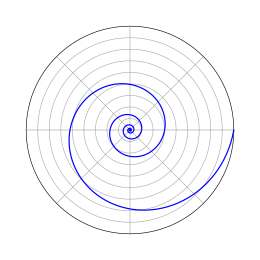Yes - the spiral is both a Bernoulli spiral and a golden spiral. All golden spirals are Bernoulli spirals but not all Bernoulli spirals are golden spirals.
Stolen from the net: "In geometry, a golden spiral is a logarithmic spiral whose growth factor is φ, the golden ratio. That is, a golden spiral gets wider (or further from its origin) by a factor of φ for every quarter turn it makes."
Well sorta. Bernoulli was a big fan of logarithmic spirals, but not all spirals are logarithmic. It depends on how it is generated. To be both a logarithmic and golden ratio it must use the golden ratio in the logarithmic equation. The golden ratio is not a finite number, but approximated. In fact most spirals that claim to be logarithmic are just approximations. Most are good enough for government work, but not true logarithmic spirals which must be drawn with the help of a computer. As you already know the shape of a logarithmic spiral depends on a variable that in the case of a golden spiral is the golden ratio. It is usually drawn in polar coordinates using the following equation:
(b is the "growth factor" and equals the golden ratio)
So, depending on how you made your template, you may not have actually used a Bernoulli (logarithmic) Spiral. Judging by your template which includes rectangles, it is quite possible you used one of the approximations. There are several similar spirals that approximate, but do not exactly equal, a golden spiral. These are often confused with the golden spiral. For example, a golden spiral can be
approximated by a "whirling rectangle diagram," in which the opposite corners of squares formed by spiraling golden rectangles are connected by quarter-circles. The result is very
similar to a true golden spiral.
Approximate and true golden spirals: the
green spiral is made from quarter-circles tangent to the interior of each square, while the
red spiral is a golden spiral, a special type of logarithmic spiral. Overlapping portions appear
yellow. The length of the side of a larger square to the next smaller square is in the golden ration:
Another approximation is a
Fibonacci spiral, which is
not a true logarithmic spiral. It is made up of a series of quarter-circular arcs whose radii are consecutively increasing Fibonacci numbers. Every quarter turn a Fibonacci spiral gets wider not by φ, but by a changing factor that equals the ratio of a term in the Fibonacci sequence to its predecessor. The ratios of consecutive terms in the Fibonacci series
approach φ, so that the two spirals are
very similar in appearance.
A Fibonacci spiral
approximates the golden spiral; unlike the "whirling rectangle diagram" based on the golden ratio, above, this one uses quarter-circle arcs inscribed in squares of integer Fibonacci-number side, shown for square sizes 1, 1, 2, 3, 5, 8, 13, 21, and 34.
Both approximations sure look a lot like your template. If your template used the logarithmic formula it wouldn't need the rectangles used by the approximations. The approximations are sure a lot easier to generate!!
Aren't you glad you decided to visit? Cam clamps, whether Fibonacci, Bernoulli, Descartes-based, etc. can be very useful in a lot of applications. Yours look useful, and appear simple and inexpensive to make. Thanks for posting!

















